tire pressure MERCEDES-BENZ CLA 2018 Owners Manual
[x] Cancel search | Manufacturer: MERCEDES-BENZ, Model Year: 2018, Model line: CLA, Model: MERCEDES-BENZ CLA 2018Pages: 326, PDF Size: 7.97 MB
Page 20 of 326
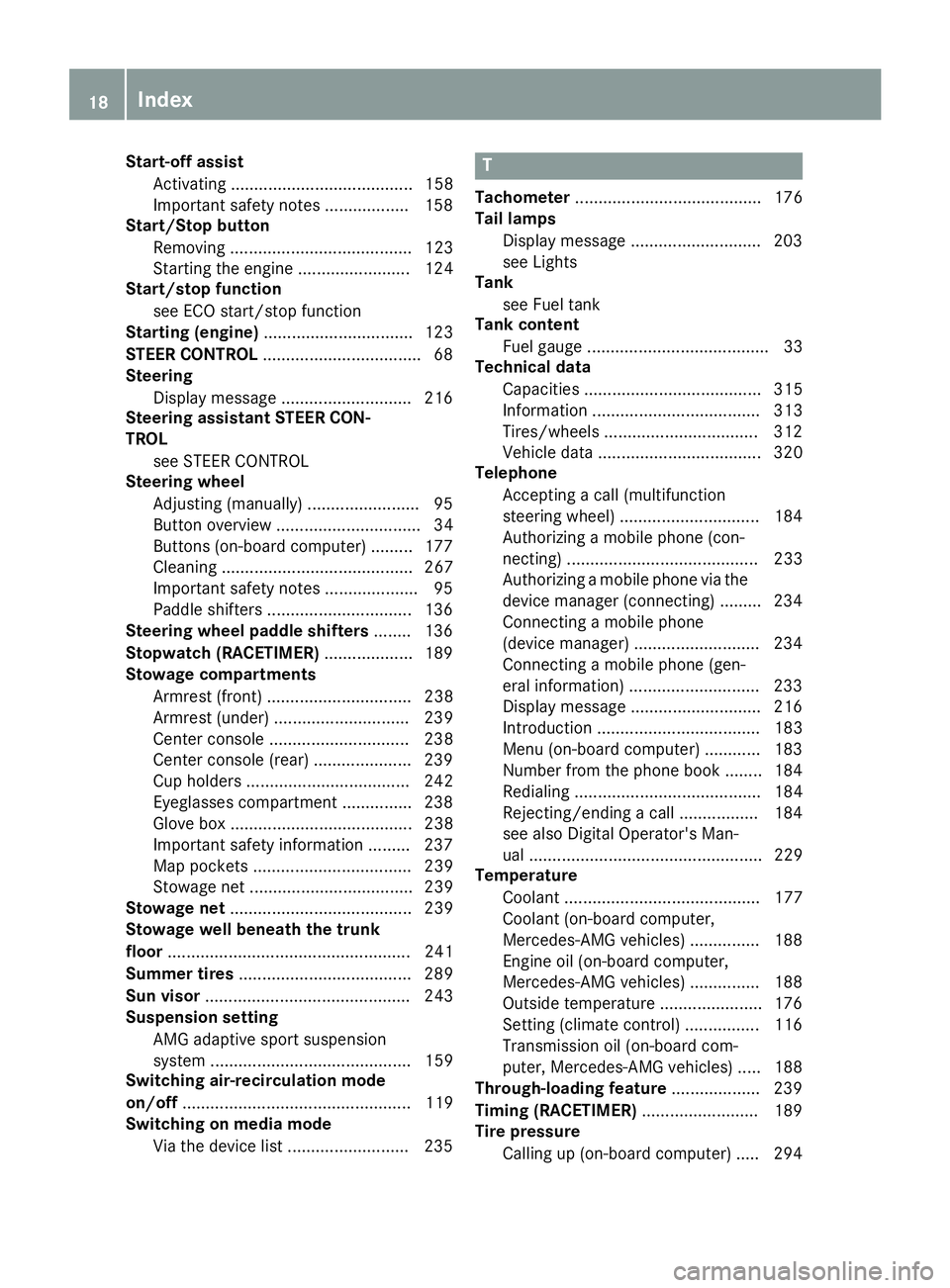
Start-off assist
Activating ....................................... 158
Important safety notes .................. 158
Start/Stop button
Removing ....................................... 123
Starting the engine ........................ 124
Start/stop function
see ECO start/stop function
Starting (engine) ................................ 123
STEER CONTROL ................................. .6 8
Steering
Display message ........................... .2 16
Steering assistant STEE RC ON-
TROL
see STEER CONTROL
Steering wheel
Adjusting (manually ). ....................... 95
Butto no verview ............................... 34
Buttons (on-board computer) ......... 177
Cleaning ......................................... 267
Important safety notes .................... 95
Paddle shifters ............................... 136
Steering whee lp addle shifters ........ 136
Stopwatch (RACETIMER) ................... 189
Stowag ec om partments
Armrest (front) ............................... 238
Armrest (under ). ............................ 239
Center console .............................. 238
Center console (rear) ..................... 239
Cu ph olders ................................... 242
Eyeglasses compartment ............... 238
Glove box ....................................... 238
Important safety information ......... 237
Ma pp ockets .................................. 239
Stowag en et ................................... 239
Stowag en et ....................................... 239
Stowag ew el lb enea th the trunk
floor .................................................... 241
Summe rt ires ..................................... 289
Sun visor ............................................ 243
Suspension setting
AMG adaptive sport suspension
system ........................................... 159
Switchin ga ir-recirculatio nm ode
on/off ................................................. 119
Switchin gonm edi am ode
Via the device list .......................... 235 T Tachometer ........................................ 176
Tail lamps
Displa ym essage ............................ 203
see Lights
Tank
see Fue lt ank
Tank content
Fue lg auge ....................................... 33
Technical data
Capacities ...................................... 315
Information .................................... 313
Tires/wheels ................................. 312
Vehicl ed at a. .................................. 320
Telephone
Accepting ac al l( multifunction
steering wheel) .............................. 184
Authorizing am obil ep hone (con-
necting) ......................................... 233
Authorizing am obil ep hone via the
device manager (connecting) ......... 234
Connecting am obil ep hone
(device manager ). .......................... 234
Connecting am obil ep hone (gen-
era li nformation) ............................ 233
Displa ym essage ............................ 216
Introduction ................................... 183
Menu (on-board computer) ............ 183
Numbe rf rom the phone boo k. ....... 184
Redialing ........................................ 184
Rejecting/ending ac al l. ................ 184
see also Digital Operator's Man-
ua l. ................................................. 229
Temperature
Coolant .......................................... 177
Coolant (on-board computer,
Mercedes-AM Gv ehicles) ............... 188
Engine oi l( on -board computer,
Mercedes-AM Gv ehicles) ............... 188
Outsid et emperature ...................... 176
Setting (climate control ). ............... 116
Transmission oi l( on -board com-
puter, Mercedes-AM Gv ehicles) ..... 188
Through-loadin gf eature ................... 239
Timing (RACETIMER) ......................... 189
Tire pressure
Calling up (on-board computer) ..... 29418
Index
Page 21 of 326
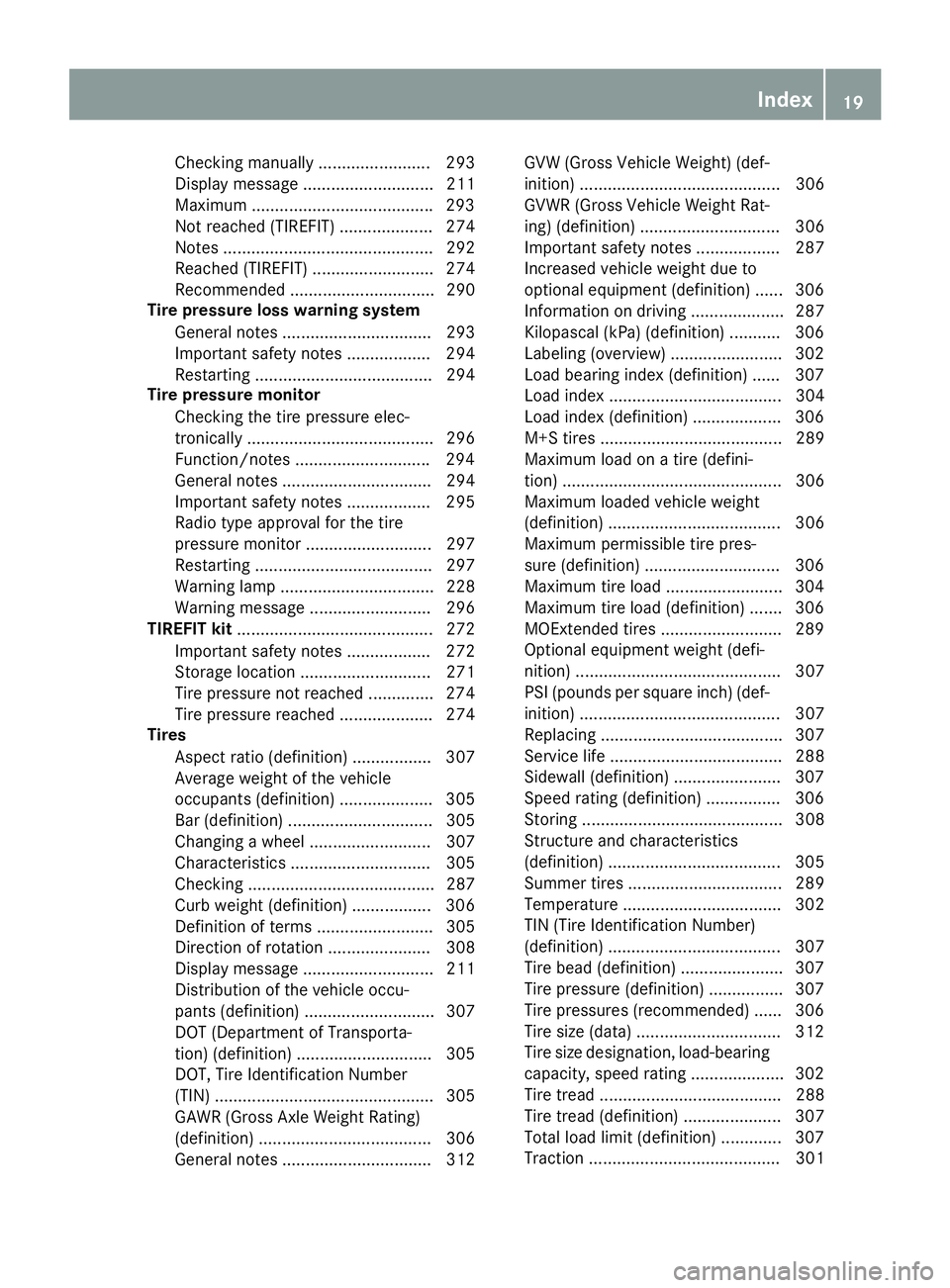
Checkin gm anually ........................ 293
Dis play message ............................ 211
Maximum ...................................... .2 93
Not reached (TIREFIT) .................... 274
Notes ............................................. 292
Reached (TIREFIT) .......................... 274
Recommended ............................... 290
Tire pressure los sw arning system
General notes ................................ 293
Important safety notes .................. 294
Restarting ...................................... 294
Tire pressure monitor
Checking the tire pressure elec-
tronically ........................................ 296
Function/notes ............................ .2 94
General notes ................................ 294
Important safety notes .................. 295
Radio type approval for the tire
pressure monitor ........................... 297
Restarting ...................................... 297
Warning lamp ................................. 228
Warning message .......................... 296
TIREFIT kit .......................................... 272
Important safety notes .................. 272
Storage location ............................ 271
Tire pressure not reached .............. 274
Tire pressure reached .................... 274
Tires
Aspect ratio (definition) ................. 307
Averag ew eight of the vehicle
occupants (definition) .................... 305
Bar (definition) ............................... 305
Changing aw heel .......................... 307
Characteristics .............................. 305
Checking ........................................ 287
Curb weight (definition) ................. 306
Definition of terms ......................... 305
Direction of rotatio n. ..................... 308
Displa ym essage ............................ 211
Distribution of the vehicl eo ccu-
pants (definition) ............................ 307
DOT (Department of Transporta-
tion) (definition) ............................. 305
DOT, T ire Identification Number
(
TIN) ............................................... 305
GAW R( Gr os sA xle Weight Rating)
(definition) ..................................... 306
Genera ln otes ................................ 312 GV W( Gr os sV ehicl eW eight) (def-
inition) ........................................... 306
GVWR (Gros sV ehicl eW eight Rat-
ing )( de finition) .............................. 306
Important safety notes .................. 287
Increased vehicl ew eigh td ue to
optiona le quipment (definition) ...... 306
Information on driving .................... 287
Kilopasca l( kPa )( de finition) ........... 306
Labeling (overview) ........................ 302
Loa db ea ring index (definition) ...... 307
Loa di ndex ..................................... 304
Loa di ndex (definition) ................... 306
M+S tire s. ...................................... 289
Maximu ml oa dona tire (defini-
tion) ............................................... 306
Maximu ml oaded vehicl ew eigh t
(definition) ..................................... 306
Maximu mp er missibl et ire pres-
sure (definition) ............................. 306
Maximu mt ire load ......................... 304
Maximu mt ire load (definition) ....... 306
MOExtended tire s. ......................... 289
Optiona le quipment weight (defi-
nition) ............................................ 307
PSI (pounds pe rs quare inch )( de f-
inition) ........................................... 307
Replacing ....................................... 307
Service life ..................................... 288
Sidewal l( de finition) ....................... 307
Speed rating (definition) ................ 306
Storing ........................................... 308
Structure and characteristics
(definition) ..................................... 305
Summer tire s. ................................ 289
Temperature .................................. 302
TIN (Tire Identification Number)
(definition) ..................................... 307
Tire bead (definition) ...................... 307
Tire pressure (definition) ................ 307
Tire pressures (recommended ). ..... 306
Tire size (data ). .............................. 312
Tire size designation, load-beari ng
ca p
acity, speed rating .................... 302
Tire trea d. ...................................... 288
Tire trea d( de finition) ..................... 307
Tota ll oa dl im it (definition) ............. 307
Tractio n. ........................................ 301 Index 19
Page 23 of 326
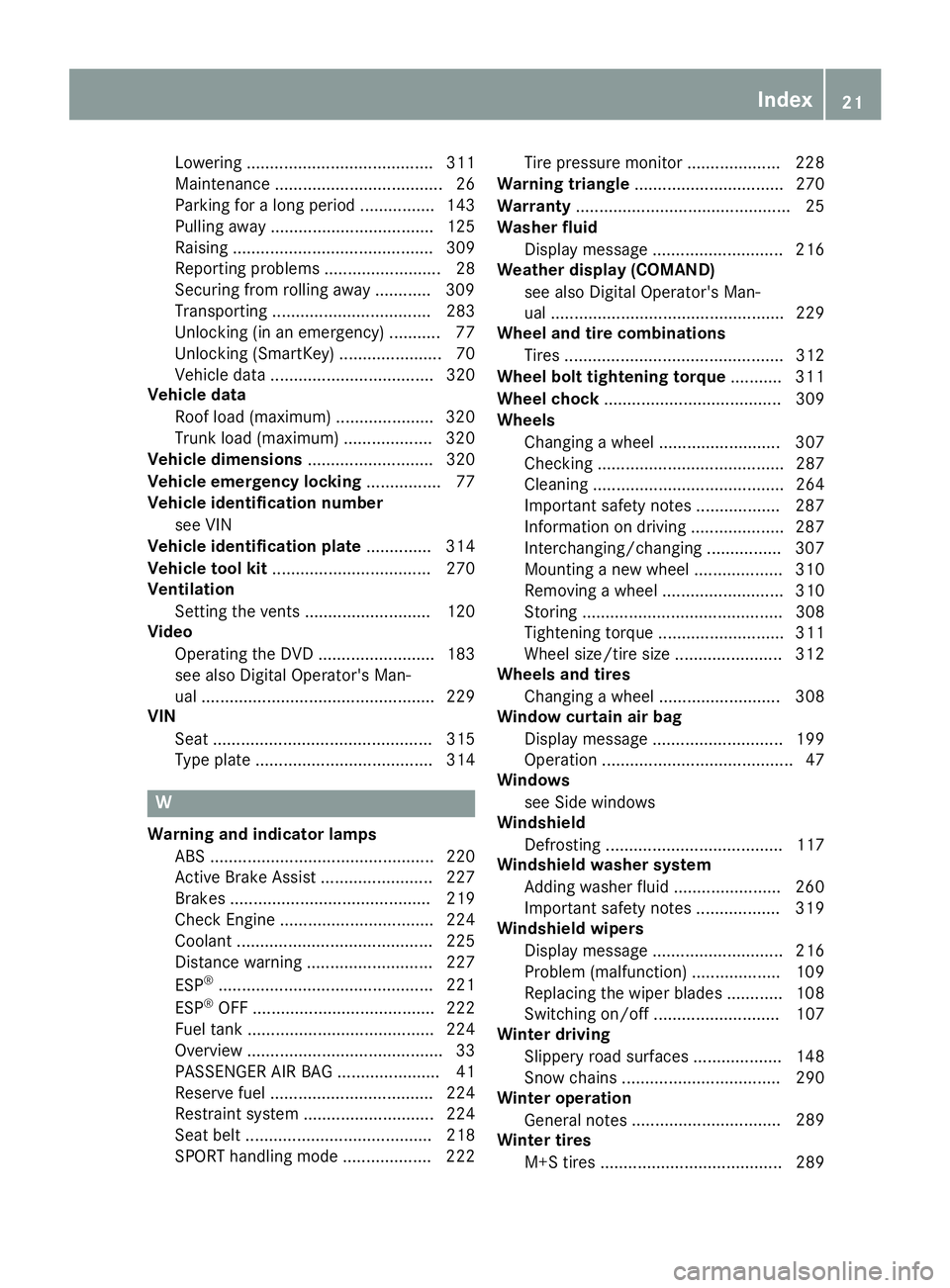
Lowering ........................................ 311
Maintenance .................................... 26
Parking for al ong perio d. ............... 143
Pulling awa y. .................................. 125
Raising ........................................... 309
Reporting problems ......................... 28
Securing from rolling away ............ 309
Transporting .................................. 283
Unlocking (i nane mergency) ........... 77
Unlocking (SmartKey ). ..................... 70
Vehicl ed at a. .................................. 320
Vehicl ed ata
Roof load (maximum) ..................... 320
Trunk load (maximum) ................... 320
Vehicl ed imensions ........................... 320
Vehicl ee mergenc yl oc king ................ 77
Vehicl ei dentificatio nn umber
see VIN
Vehicl ei dentificatio np late .............. 314
Vehicl et oo lk it .................................. 270
Ventilation
Setting the vents ........................... 120
Video
Operating the DVD ......................... 183
see also Digital Operator's Man-
ua l. ................................................. 229
VIN
Sea t. .............................................. 315
Type plate ...................................... 314
W
Warning and indicator lamps
ABS ................................................ 220
Active Brake Assist ........................ 227
Brakes ........................................... 219
Check Engine ................................. 224
Coolant .......................................... 225
Distance warning ........................... 227
ESP ®
.............................................. 221
ESP ®
OFF ....................................... 222
Fue lt ank ........................................ 224
Overview .......................................... 33
PASSENGER AIR BAG ...................... 41
Reserve fue l. .................................. 224
Restraint system ............................ 224
Sea tb el t. ....................................... 218
SPOR Th an dling mod e. .................. 222 Tire pressure monitor .................... 228
Warning triangle ................................ 270
Warranty .............................................. 25
Washer fluid
Displa ym essage ............................ 216
Weather display (COMAND)
see also Digital Operator's Man-
ua l. ................................................. 229
Wheel and tire combinations
Tires ............................................... 312
Wheel bolt tightenin gt orque ........... 311
Wheel chock ...................................... 309
Wheels
Changing aw heel .......................... 307
Checking ........................................ 287
Cleaning ......................................... 264
Important safety notes .................. 287
Information on driving .................... 287
Interchanging/changing ................ 307
Mounting an ew whee l. .................. 310
Removing aw heel .......................... 310
Storing ........................................... 308
Tightening torque ........................... 311
Wheel size/tire size ....................... 312
Wheel sa nd tires
Changing aw heel .......................... 308
Window curtai na ir bag
Displa ym essage ............................ 199
Operation ......................................... 47
Windows
see Sid ew in dows
Windshield
Defrosting ...................................... 117
Windshiel dw asher system
Adding washe rf luid ....................... 260
Important safety notes .................. 319
Windshiel dw ip ers
Displa ym essage ............................ 216
Problem (malfunction) ................... 109
Replacing the wipe rb lade s. ........... 108
Switching on/of f. .......................... 107
Winter driving
Slippery roa ds ur faces ................... 148
Snow chains .................................. 290
Winter operation
Genera ln otes ................................ 289
Wi n
ter tires
M+S tire s. ...................................... 289Index 21
Page 26 of 326
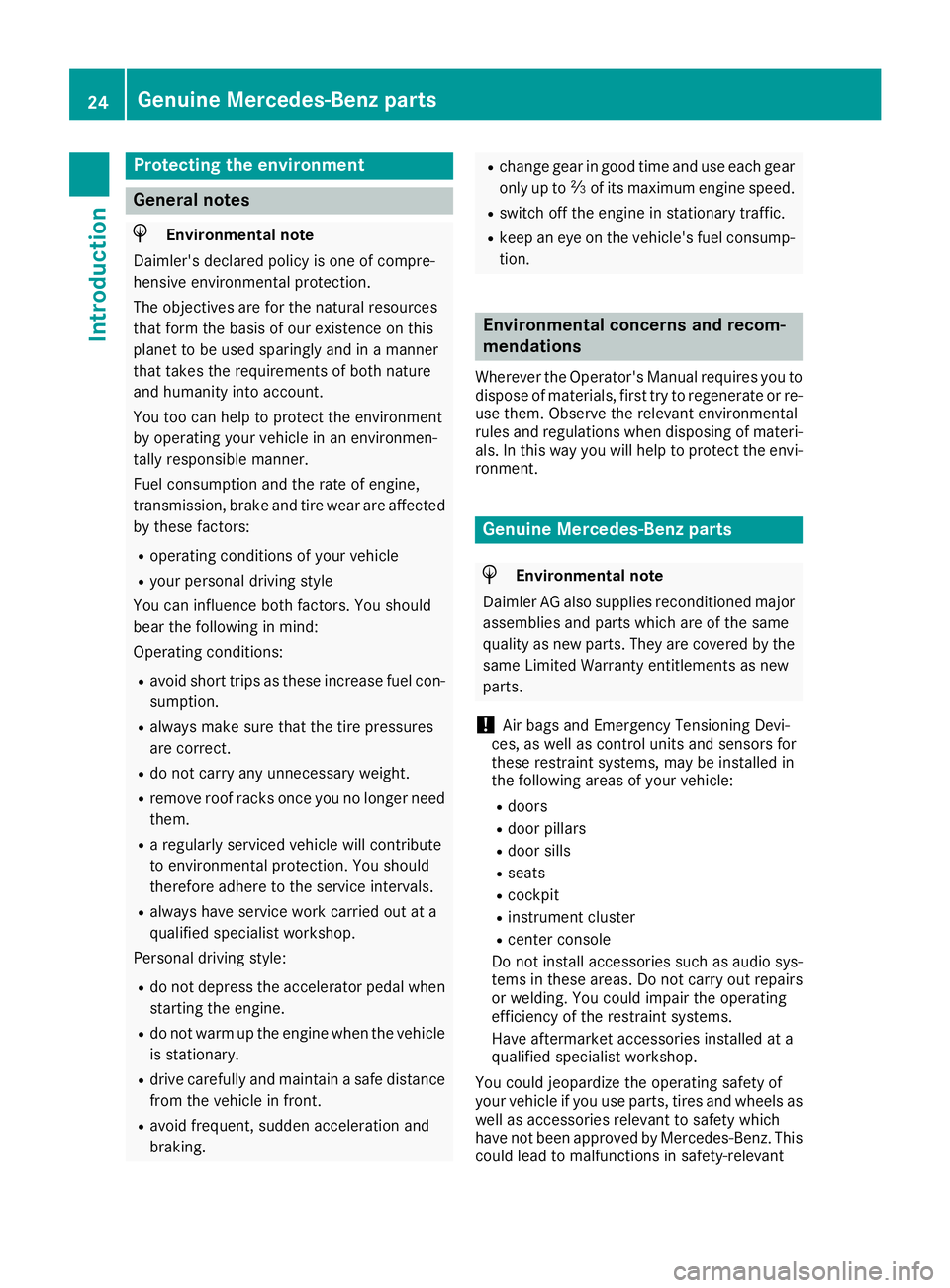
Protecting the environment
General notes
H Environmental note
Daimler's declared policy is one of compre-
hensive environmental protection.
The objectives are for the natural resources
that form the basis of our existence on this
planet to be used sparingly and in am anner
that takes the requirements of both nature
and humanity into account.
You too can help to protect the environment
by operating your vehicle in an environmen-
tally responsible manner.
Fuel consumption and the rate of engine,
transmission, brake and tire wear are affected
by these factors: R
operating condition sofy our vehicleR
your personal driving style
You can influence both factors. You should
bear the following in mind:
Operating conditions: R
avoid short trips as these increase fuel con-
sumption. R
always make sure that the tire pressures
are correct. R
do not carry any unnecessary weight. R
remove roof racks once you no longer need
them. R
ar egularly serviced vehicle will contribute
to environmental protection. You should
therefore adhere to the service intervals. R
always have service work carried out at a
qualified specialist workshop.
Personal driving style: R
do not depress the accelerator pedal when
startin gt he engine.R
do not warm up the engine when the vehicle
is stationary. R
drive carefully and maintain as afe distance
from the vehicle in front. R
avoid frequent, sudden acceleration and
braking. R
change gear in good time and use each gear
only up to �
Page 63 of 326
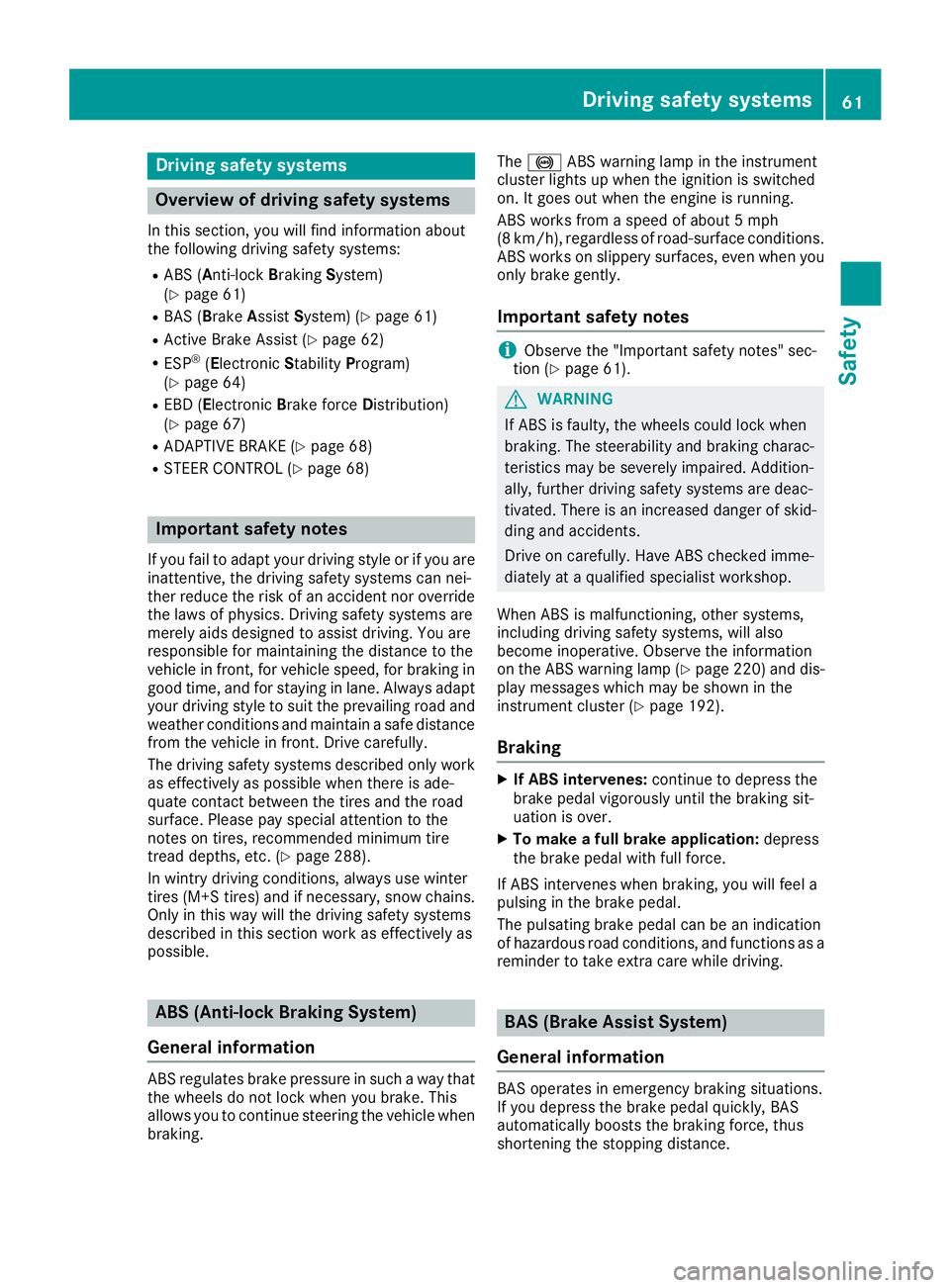
Drivin gs af et ys ystems
Overview of drivin gs af et ys ystemsIn this section ,y ou will fin di nformati on about
th ef ol lowin gd rivin gs afet ys ystems :R
AB S( A nti-lock B rakin g S ystem)
( Y
page 61) R
BA S( B rak e A ssist S ystem) ( Y
page 61)R
Active Brak eA ss is t( Y
page 62 )R
ES P ®
( E lectronic S ta bility P ro gram)
( Y
page 64) R
EB D( E lectroni c B rak ef orce D istribution )
( Y
page 67 )R
ADAPTIV EB RAKE ( Y
page 68 )R
STEE RC ONTROL ( Y
page 68)
Important safet yn otesIf you fail to adapt your drivin gs ty le or if you are
inattentive ,t he drivin gs afet ys ystems can nei-
ther reduce th er is kofana cciden tn or override
th el aws of physics. Driving safet ys ystems are
merely aids designed to assist driving. You are
responsible fo rm aintainin gt he distanc etot he
vehicle in front, fo rv ehicle speed, fo rb raking in
goo dt im e, and fo rs ta yin ginl ane. Always adapt
your drivin gs ty le to suit th ep revailin gr oa da nd
weather condition sa nd maintain as af ed istanc e
from th ev ehicle in front. Drive carefully.
The drivin gs afet ys ystems described only wor k
as effectively as possible when there is ade-
quat ec ontac tb etween th et ir es and th er oa d
surface. Please pay special attention to th e
note sont ir es ,r ecommended minimum tire
tread depths, etc. ( Y
page 288).
In wintr yd rivin gc onditi ons, always use winte r
tires (M+ St ir es )a nd if necessary ,s now chains.
Onl yint hi sw ay will the driving safety systems
describe dint hi ss ection work as effectively as
possible.
ABS (Anti-lock Brakin gS ystem)
General information
ABS regulate sb rake pressure in such aw ay that
the wheels do not lock when yo ub rake. This
allows yo utoc ontinue steering the vehicl ew he n
braking. The �% ABS warning lamp in the instrument
cluster lights up when the ignition is switched
on. It goe so ut when the engine is running.
ABS works from as peed of abou t5m ph
(8 km/h), regardless of road-surface conditions.
ABS works on slippery surfaces, eve nw he ny ou
onl yb rake gently.
Important safety notes
i Observe the "Important safety notes "s ec-
tio n( Y
page 61).
G WARNING
If ABS is faulty ,t he wheels could lock when
braking .T he steerability and braking charac-
teristic sm ay be severely impaired .A ddition-
ally ,f urther driving safety system sa re deac-
tivated .T here is an increased danger of skid-
ding and accidents.
Driv eonc arefully. Hav eA BS checked imme-
diately at aq uali fied specialist workshop.
Whe nA BS is malfunctioning ,o the rs ys tems,
including driving safety systems, will also
become inoperative. Observe the information
on the ABS warning lamp ( Y
page 220 )a nd dis-
play messages which ma ybes hown in the
instrument cluster ( Y
page 192).
Braking X
If ABS intervenes: continue to depress the
brake peda lv igorously unti lt he braking sit-
uatio ni so ver. X
To make af ul lb rake application: depress
the brake peda lw it hf ul lf orce.
If ABS intervene sw he nb raking ,y ou will fee la
pulsing in the brake pedal.
The pulsating brake peda lc an be an indication
of hazardou sr oa dc onditions, and functions as a
reminder to take extra car ew hile driving.
BAS (Brak eA ssis tS ystem)
General information
BAS operates in emergency braking situations.
If yo ud ep ress the brake peda lq ui ckly, BAS
automaticall yb oo sts the braking force ,t hus
shortening the stopping distance.Driving safety systems 61
Safety Z
Page 146 of 326
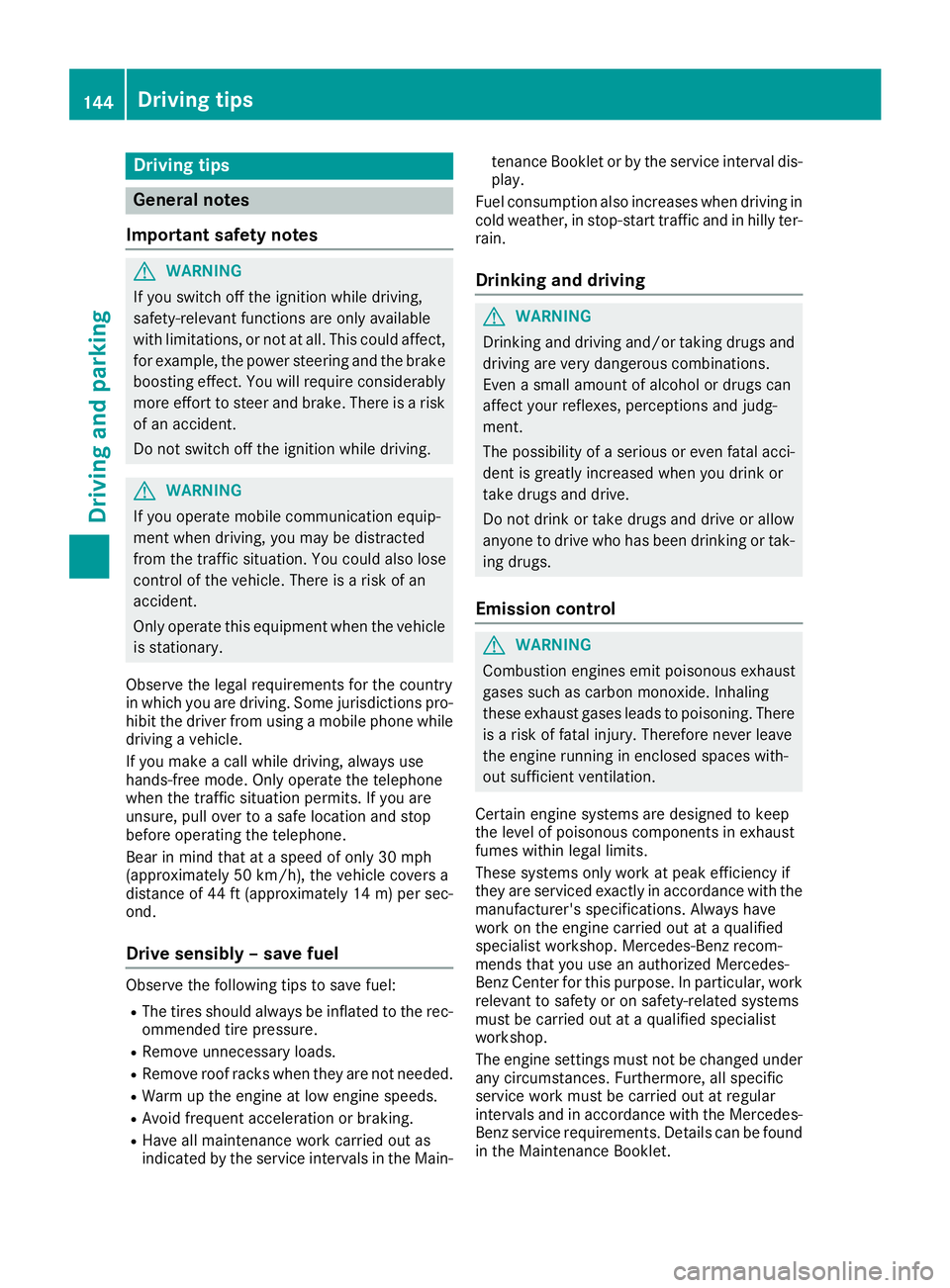
Drivin gt ip s
General notes
Important safet yn otes
G WARNING
If you switch of ft he ignition whil ed riving,
safety-relevant function sa re only available
wit hl imitations, or no tata ll. Thi sc ou ld affect,
fo re xa mple, th ep owe rs te erin ga nd th eb rake
boostin ge ffect. You will require considerably
more effort to steer and brake .T here is ar is k
of an accident.
Do no ts witch of ft he ignition whil ed riving.
G WARNING
If you operat em ob ile communication equip -
men tw hen driving, you may be distracted
from th et ra ffic situation .Y ou could also los e
contro loft he vehicle. There is ar is kofa n
accident.
Only operat et hi se quipmen tw hen th ev ehicle
is stationary.
Observ et he lega lr equirements fo rt he country
in whic hy ou are driving. Some jurisdiction sp ro -
hibi tt he driver from usin gam ob ile phone whil e
drivin gav ehicle.
If you mak eac al lw hil ed riving, always use
hands-free mode. Only operat et he telephon e
when th et ra ffic situation permits. If you are
unsure ,p ull over to as af el ocation and stop
befor eo peratin gt he telephone.
Bear in min dt ha tatas peed of only 30 mph
(approximately 50 km/h), th ev ehicle cover sa
distanc eo f4 4f t( approximately 14 m) per sec-
ond.
Drive sensibly –s ave fuelObserve the following tips to save fuel: R
The tires should always be inflated to the rec-
ommended tire pressure. R
Remove unnecessary loads. R
Remove roof rack sw hen they are not needed.R
Warm up the engin eatl ow engin es peeds.R
Avoid frequen ta cceleration or braking.R
Have all maintenanc ew ork carried out as
indicated by the servic ei ntervals in the Main- tenance Booklet or by the servic ei nterval dis-
play.
Fuel consumption also increases when driving in
cold weather, in stop-start traffic and in hilly ter-
rain.
Drinking and driving
G WARNING
Drinkin ga nd driving and/or takin gd rugs and
driving are very dangerous combinations.
Even as mall amount of alcohol or drugs can
affect your reflexes, perceptions and judg-
ment.
The possibility of as erious or even fatal acci-
dent is greatly increased when you drink or
take drugs and drive.
Do not drink or take drugs and drive or allow
anyone to drive who has been drinking or tak-
ing drugs.
Emission control
G WARNING
Combustion engines emit poisonous exhaust
gases such as carbon monoxide. Inhaling
these exhaust gases leads to poisoning. There
is ar isk of fatal injury. Therefor en ever leave
the engin er unning in enclosed spaces with-
out sufficien tv entilation.
Certain engin es ystems are designed to keep
the level of poisonous component sine xhaust
fumes within legal limits.
These systems only work at peak efficiency if
they are serviced exactly in accordance with the
manufacturer's specifications .A lways have
work on the engin ec arried out at aq ualified
specialist workshop. Mercedes-Benz recom-
mends that you use an authorized Mercedes-
Ben zC enter for this purpose. In particular, work
relevant to safety or on safety-related systems
must be carried out at aq ualified specialist
workshop.
The engin es ettings must not be changed under
any circumstances. Furthermore, all specific
servic ew ork must be carried out at regular
intervals and in accordance with the Mercedes-
Ben zs ervic er equirements. Details can be found
in the Maintenance Booklet.144
Driving tips
Driving and parking
Page 148 of 326
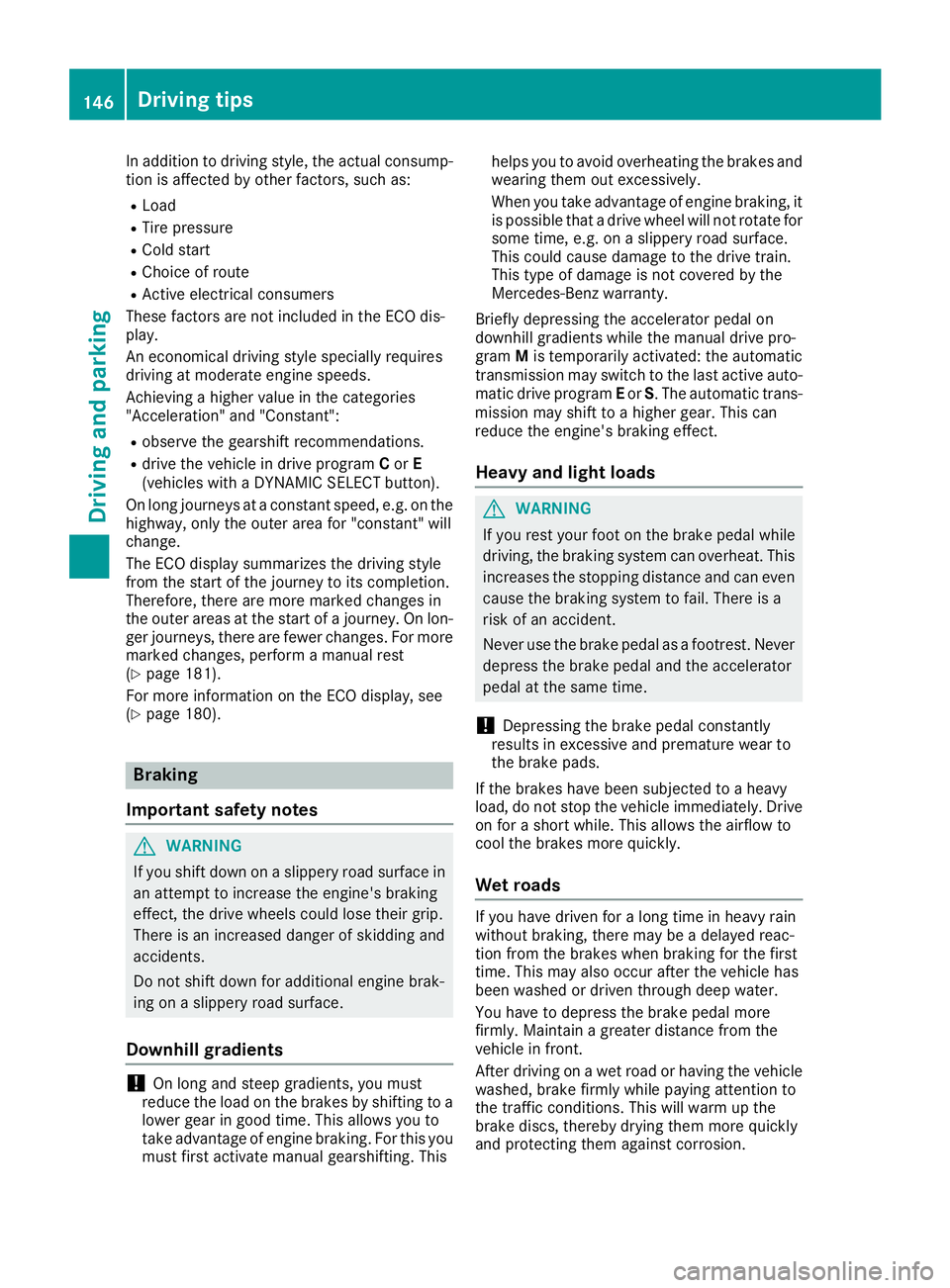
In addition to driving style, the actual consump-
tion is affected by other factors, such as: R
Load R
Tire pressure R
Cold start R
Choice of route R
Active electrical consumers
These factors are not include dint he ECO dis-
play.
An economical driving style specially requires
driving at moderate engine speeds.
Achieving ah igher valu eint he categories
"Acceleration" and "Constant": R
observe the gearshift recommendations. R
drive the vehicle in drive program C or E
(vehicles with aD YNAMIC SELECT button).
On long journeys at ac onstant speed ,e .g. on the
highway, only the outer area for "constant" will
change.
The ECO display summarizes the driving style
from the start of the journey to its completion.
Therefore, there are more marked changes in
the outer area satt he start of aj ourney. On lon-
ger journeys, there are fewer changes. For more
marked changes, perform am anua lr est
( Y
page 181).
For more information on the ECO display, see
( Y
page 180).
Braking
Important safety notes
G WARNING
If you shift down on as lippery road surface in
an attempt to increase the engine's braking
effect, the drive wheel sc ould lose their grip.
There is an increased danger of skidding and
accidents.
Do not shift down for additional engine brak-
ing on as lippery road surface.
Downhill gradients
! On long and steep gradients, you must
reduce the load on the brakes by shifting to a
lowe rg ear in good time. This allows you to
take advantage of engine braking. For this you
must first activate manua lg earshifting. This helps you to avoid overheating the brakes and
wearing them out excessively.
When you take advantage of engine braking, it
is possible that ad rive wheel wil ln ot rotate for
some time, e.g. on as lippery road surface.
This could cause damage to the drive train.
This type of damage is not covered by the
Mercedes-Benz warranty.
Briefly depressing the accelerator peda lo n
downhill gradients whil et he manua ld rive pro-
gram M is temporaril ya ctivated: the automatic
transmission may switch to the last active auto-
matic drive program E or S .T he automatic trans-
missio nm ay shift to ah ighe rg ear. This can
reduce the engine's braking effect.
Heavy and light loads
G WARNING
If you rest you rf oot on the brake peda lw hile
driving, the braking system can overheat. This
increases the stopping distance and can even
cause the braking system to fail .T here is a
risk of an accident.
Never use the brake peda lasaf ootrest. Never
depres st he brake peda la nd the accelerator
peda latt he same time.
! Depressing the brake peda lc onstantly
results in excessive and premature wea rt o
the brake pads.
If the brakes have been subjected to ah eavy
load ,don ot stop the vehicle immediately .D rive
on for as hort while. This allows the airflow to
cool the brakes more quickly.
Wet roads If you have driven for al ong time in heavy rain
withou tb raking, there may be ad elayed reac-
tion from the brakes when braking for the first
time. This may also occur after the vehicle has
been washed or driven through deep water.
You have to depres st he brake peda lm ore
firmly .M aintai nag reater distance from the
vehicle in front.
After driving on aw et road or having the vehicle
washed, brake firmly whil ep aying attention to
the traffic conditions. This wil lw arm up the
brake discs, thereby drying them more quickly
and protecting them against corrosion.146
Driving tips
Driving and parking
Page 166 of 326

Parking Pilot
General notes Parking Pilot is an electronic parking aid with
ultrasound. It measures the road on both sides
of the vehicle. Ap arking symbol indicates as uit-
able parking space. Active steering intervention
and brake application can assist you during
parking and when exiting ap arking space. Park-
ing Assist PARKTRONIC is also available
( Y
page 161).
Important safety notes Parking Pilot is only an aid. It is not ar eplace-
ment for your attention to your immediate sur-
roundings. You are always responsible for safe
maneuvering, parking and exiting ap arking
space. Make sure that no persons, animals or
object sa re in the maneuvering range.
When Parking Assist PARKTRONIC is deactiva-
ted, Parking Pilot is also unavailable.
G WARNING
While parking or pulling out of ap arking
space, the vehicle swings out and can drive
onto areas of the oncomin gl ane. This could
result in ac ollision with another road user.
There is ar isk of an accident.
Pay attention to other road users. Stop the
vehicle if necessary or cancel the Parking Pilot
parking procedure.
! If unavoidable ,y ou should drive over obsta-
cles such as curbs slowly and not at as harp
angle. Otherwise, you may damage the
wheels or tires.
Parking Pilot may also display spaces not suita-
ble for parking, e.g.: R
where parking or stopping is prohibited R
in front of driveways or entrances and exits R
on unsuitable surfaces
Parking tips: R
On narrow roads, drive as close to the parking
space as possible. R
Parking spaces that are littered or overgrown
might be identified or measured incorrectly. R
Parking spaces that are partially occupied by
trailer drawbars might not be identified as
such or be measured incorrectly. R
Snowfall or heavy rain may lead to ap arking
space being measured inaccurately. R
Pay attention to the warning messages of
Parking Pilot PARKTRONIC during the parking
procedure ( Y
page 162). R
You can intervene to correct the steering pro-
cedure at any time. Parking Pilot will then be
canceled. R
When transporting al oad that protrudes from
your vehicle, you must not use Parking Pilot. R
Never use Parking Pilot when snow chains are
mounted. R
Make sure that the tire pressures are always
correct .T his has ad irect influence on the
parking characteristics of the vehicle.
Use Parking Pilot for parking spaces that are: R
that are paralle loratr ight-angles to the direc-
tion of travel R
on straight roads, not bends R
on the same level as the road, e.g. not on the
pavement
Detecting parking spaces Object sl ocated above the detection range of
Parking Pilot will not be detected when the park-
ing space is measured. These are not taken into
account when the parking procedure is calcula-
ted, e.g. overhanging loads, truck overhangs or
loading ramps. Parking Pilot may therefore
guide you into the parking space too early.
Parking Pilot does not assist you parking in
spaces perpendicular to the direction of travel if: R
two parking spaces are located directly next
to one another R
the parking space is directly next to al ow
obstacle such as al ow curbR
you forward-park
Parking Pilot does not assist you parking in
spaces paralle lorp erpendicular to the direction
of travel if: R
the parking space is on ac urbR
the system reads the parking space as being
blocked, for example by foliage or grass pav-
ing blocks R
the area is too small for the vehicle to maneu-
ver into R
the parking space is bordered by an obstacle,
e.g. at ree, ap ost or at railer
For further information on the detection range
( Y
page 161).164
Driving systems
Driving and parking
Page 213 of 326
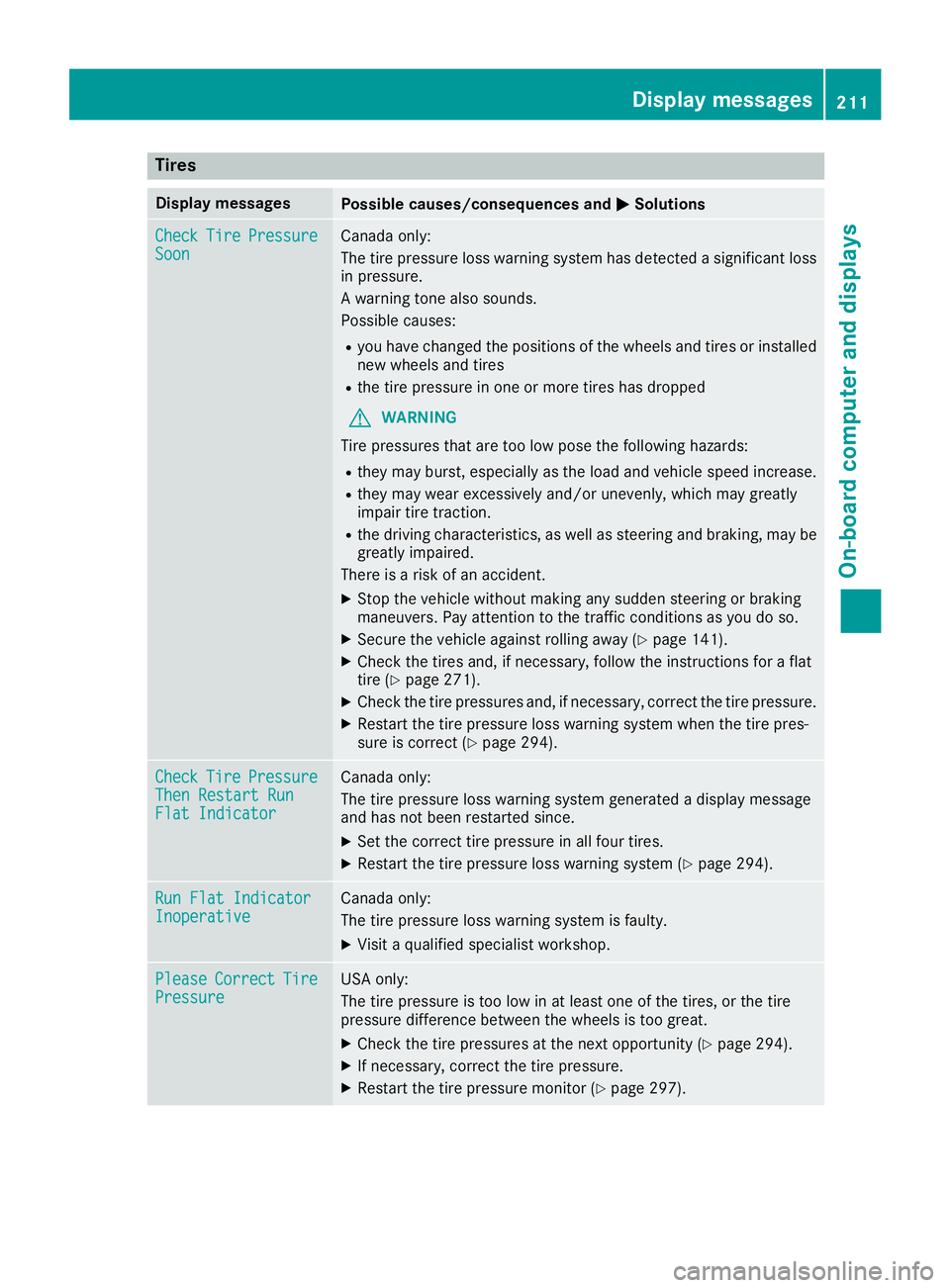
Tires Display messages
Possible causes/consequence sa nd �P Solutions
Check Tire Pressure
Soon Canad ao nly:
The tire pressure loss warning system ha sd et ecte das ig nificant loss
in pressure.
Aw ar ning tone also sounds.
Possibl ec auses: R
yo uh av ec hange dt he positions of the wheels and tire sori nstalled
new wheels and tires R
the tire pressure in one or mor et ire sh as dropped
G WARNING
Tire pressures tha ta re too lo wp os et he following hazards:R
the ym ay burst, especially as the load and vehicl es peed increase.R
the ym ay wear excessivel ya nd/or unevenly, which ma yg reatly
impai rt ire traction. R
the drivin gc haracteristics, as well as steerin ga nd braking ,m ay be
greatl yi mpaired.
There is ar is kofana ccident.X
Stop the vehicl ew it hou tm ak ing any sudden steerin gorb raking
maneuvers. Pa ya ttentio ntot he traffi cc onditions as yo udos o.X
Secure the vehicl ea gain st rolling away ( Y
page 141).X
Check the tire sa nd ,ifn ecessary ,f ollo wt he instructions for af lat
tire ( Y
page 271). X
Check the tire pressures and ,ifn ecessary ,c orrect the tire pressure.X
Restart the tire pressure loss warning system when the tire pres-
sure is correct ( Y
page 294).
Check Tire Pressure
The nR estar tR un
Fla tI ndicator Canad ao nly:
The tire pressure loss warning system generated ad isplay message
and ha sn ot been restarted since. X
Set the correct tire pressure in al lf ou rt ires.X
Restart the tire pressure loss warning system ( Y
page 294).
Run Fla tI ndicator
Inoperative Canad ao nly:
The tire pressure loss warning system is faulty. X
Visi taq uali fied specialis tw or kshop.
Please Correct Tire
Pressure USA only:
The tire pressure is too lo winatl east one of the tires, or the tire
pressure differenc eb et ween the wheels is too great.X
Check the tire pressures at the next opportunity ( Y
page 294).X
If necessary ,c orrect the tire pressure.X
Restart the tire pressure monitor ( Y
page 297).Displa ym essages 21 1
On-boar dc omputer an dd isplays Z
Page 214 of 326
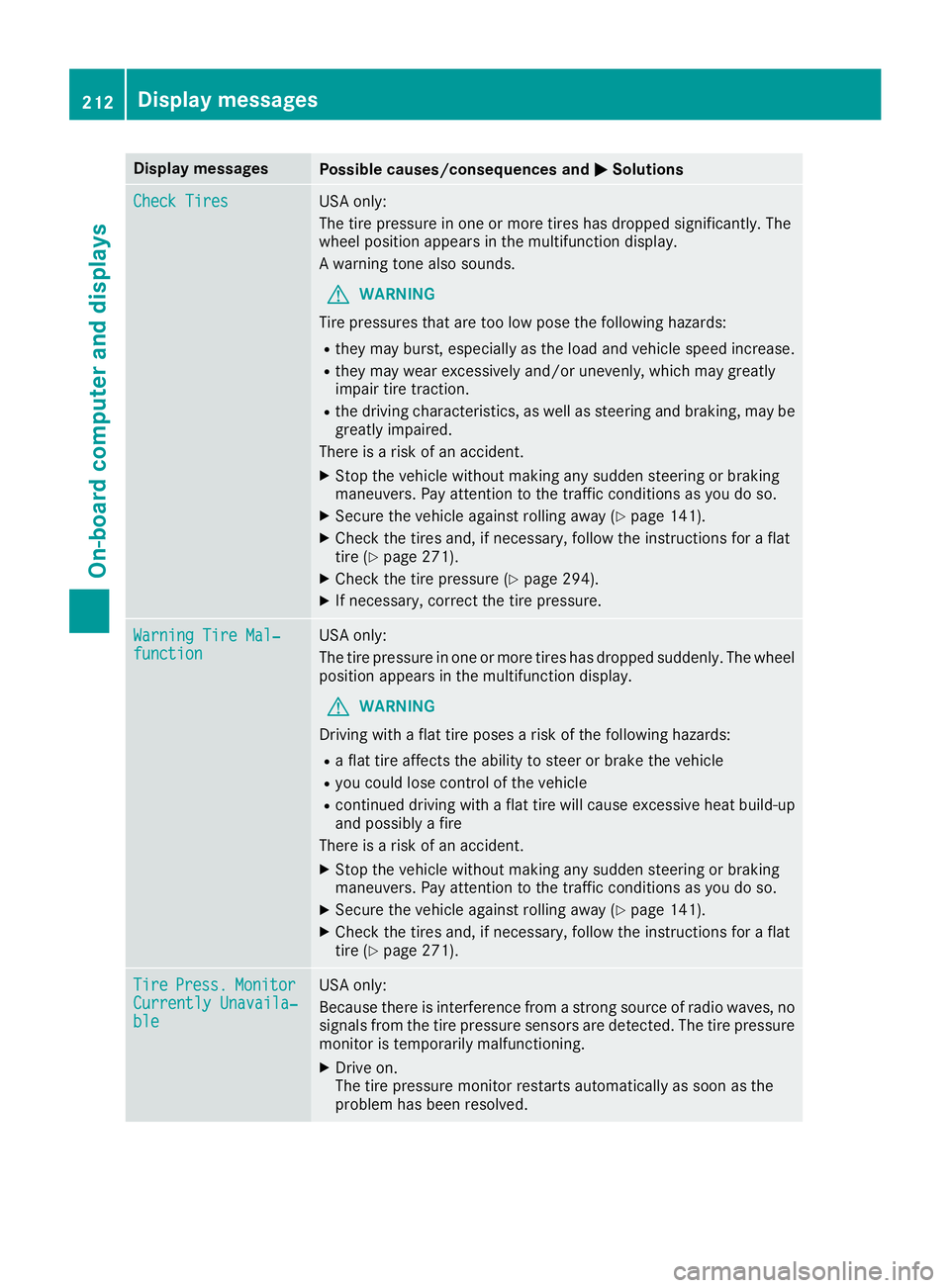
Display messages
Possible causes/consequences and �P Solutions
Check Tires US Ao nl y:
The tire pressur eino ne or mor et ir es has dropped significantly. The
whee lp osition appear sint he multifunction display.
Aw arning tone also sounds.
G WARNIN G
Tir ep ressures that are to ol ow pos et he followin gh azards :R
they may burst, especially as th el oad and vehicl es peed increase.R
they may wear excessivel ya nd/o ru nevenly, whic hm ay greatl y
impair tire traction .R
th ed rivin gc ha racteristics ,asw ell as steering and braking ,m ay be
greatl yi mpaired.
There is ar is kofana ccident.X
Stop th ev ehicl ew ithout making any sudden steering or braking
maneuvers .P ay attention to th et ra ffic condition sasy ou do so.X
Secur et he vehicl ea gainst rollin ga way ( Y
page 141).X
Chec kt he tires and ,ifn eces sary, follow th ei nstruction sf or af lat
tire ( Y
page 271). X
Chec kt he tire pressur e( Y
page 294).X
If necessary, correc tt he tire pressure.
Warnin gT ir eM al ‐
function US Ao nl y:
The tire pressur eino ne or mor et ir es has dropped suddenly. The whee l
position appear sint he multifunction display.
G WARNIN G
Drivin gw it haf lat tire poses ar is koft he followin gh azards :R
af lat tire affects th ea bilit yt os te er or brak et he vehicl eR
you could lose control of th ev ehicl eR
continued drivin gw it haf lat tire will caus ee xces sive heat build-up
and possibl yaf ir e
There is ar is kofana ccident.X
Stop th ev ehicl ew ithout making any sudden steering or braking
maneuvers .P ay attention to th et ra ffic condition sasy ou do so.X
Secur et he vehicl ea gainst rollin ga way ( Y
page 141).X
Chec kt he tires and ,ifn eces sary, follow th ei nstruction sf or af lat
tire ( Y
page 271).
Tir e Press. Monito r
Currently Unavaila‐
ble US Ao nl y:
Becaus et he re is interferenc ef ro mas tr on gs ource of radi ow aves, no
signals from th et ir ep ressur es ensor sa re detected. The tire pressur e
monitor is temporarily malfunctioning .X
Drive on .
The tire pressur em onitor restarts automatically as soo nast he
problem has been resolved.212
Display messages
On-boar dc omputer an dd isplays